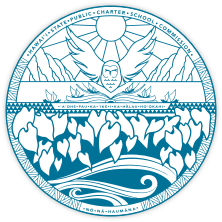Earlier this spring, the State Public Charter School Commission spotlighted a powerful new video initiative led by Commission Chair Dr. Makalapua Alencastre: ʻAuhea ʻOukou e Nā Kumu—A Call to All Kumu.
Dr. Alencastre recently stepped into the role of video producer to help create a powerful 25-minute Hawaiian Kumu recruitment video. As a Hawaiian educator with over 40 years of experience, Dr. Alencastre recently retired as an Associate Professor at Ka Haka ʻUla o Keʻelikōlani College of Hawaiian Language at the University of Hawaiʻi at Hilo. Throughout her career—spanning elementary, secondary, and university levels—she witnessed firsthand the growing demand for more kumu (teachers) in Hawaiian language education.
Determined to inspire the next generation of educators, Dr. Alencastre spearheaded the production of ʻAuhea ʻOukou e Nā Kumu—A Call to All Kumu. The video serves as a passionate invitation: The future is calling, and it needs you. Dr. Alencastre noted that the last kumu recruitment video was made in 1990—35 years ago. To bring this new film to life, she interviewed 20 kumu from across the islands, highlighting the experiences of educators at public charter and DOE schools, including Ka ʻUmeke Kāʻeo, Ke Kula ʻo Samuel M. Kamakau, Kawaikini, Ke Kula ʻo Nāwahīokalaniʻōpuʻu, as well as schools in Pāhoa, Lahaina, Lānaʻi, Molokaʻi, and Waiau, along with kumu from ʻAha Pūnana Leo preschools.
The video sheds light on a critical issue: the urgent need for more Hawaiian language teachers. Currently, 40 Hawaiian immersion schools exist, yet many have waitlists due to a shortage of kumu. Communities are eager to open new immersion schools and expand existing programs, but the lack of qualified teachers remains a significant barrier. ʻAuhea ʻOukou e Nā Kumu is a rallying cry, encouraging passionate individuals to pursue Hawaiian immersion education and help meet the growing demand.
Through heartfelt testimonies, kumu share the deep fulfillment they find in their work—cultivating cultural identity, revitalizing the Hawaiian language, and strengthening communities. The video also provides historical context, reminding viewers that Hawaiian language was banned in public schools in 1896, just three years after the overthrow of the Hawaiian Kingdom. The near loss of the language spurred a powerful movement, leading to the establishment of ʻAha Pūnana Leo preschools and the Kaiapuni Hawaiian Immersion program in public schools.
Interested in becoming a kumu or know someone who might be interested, visit this website for more information on degree programs and scholarship opportunities.

